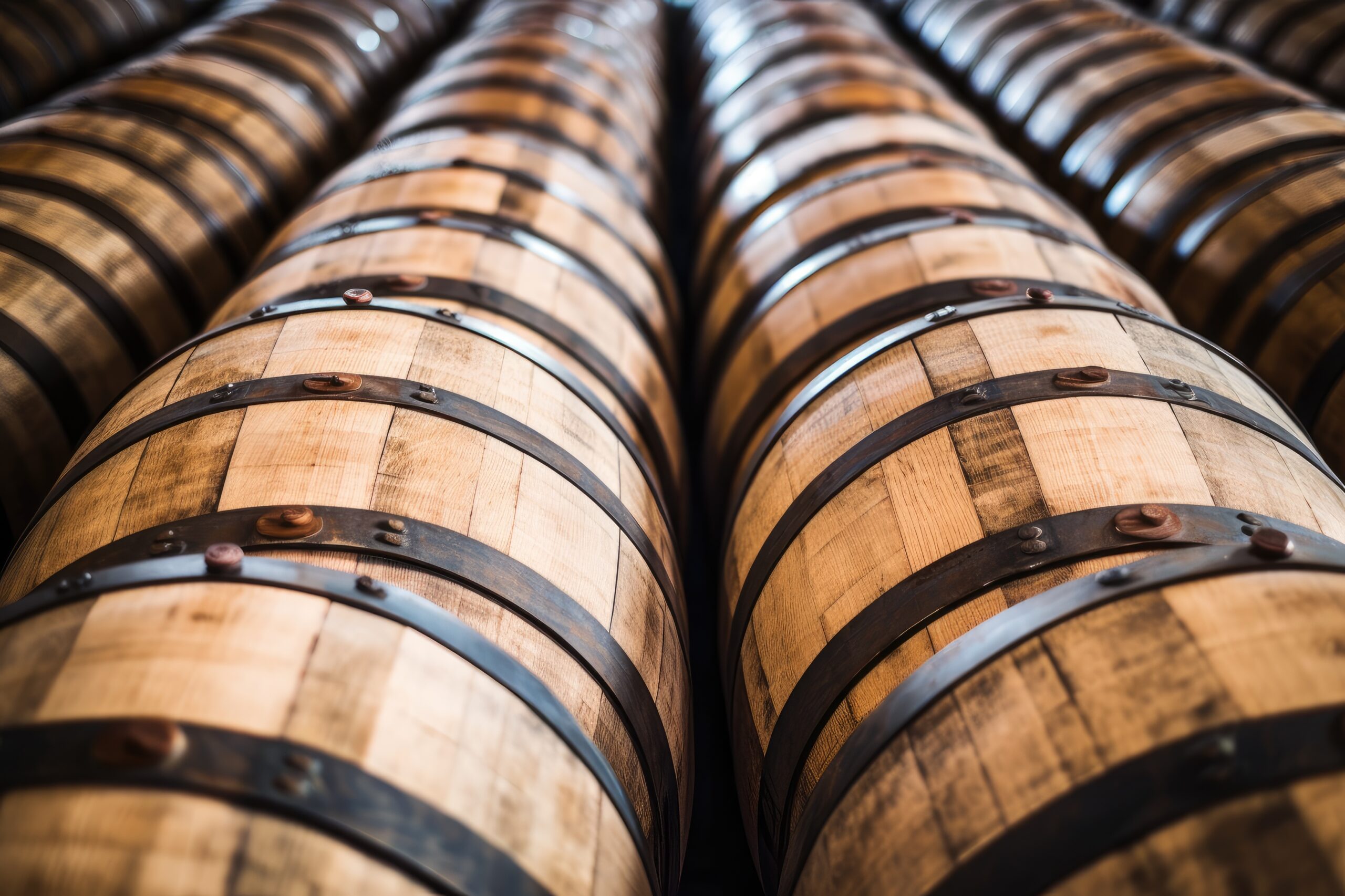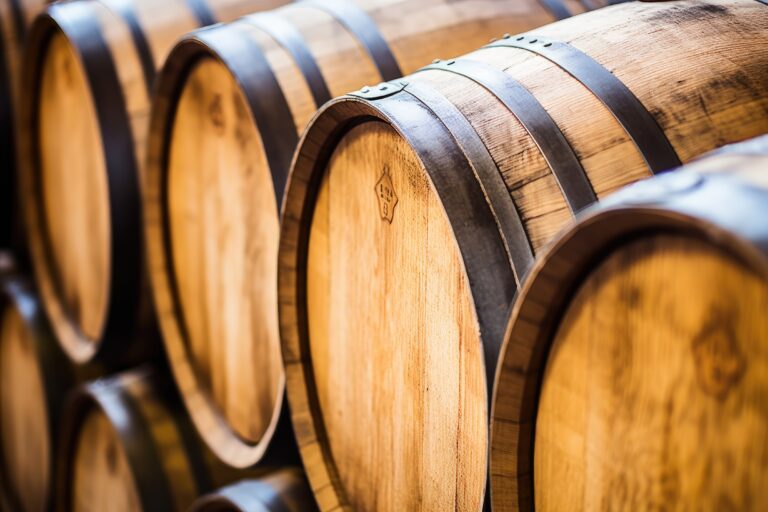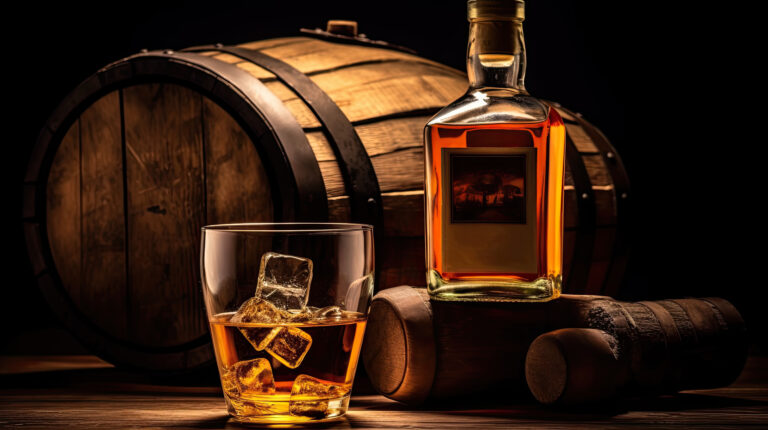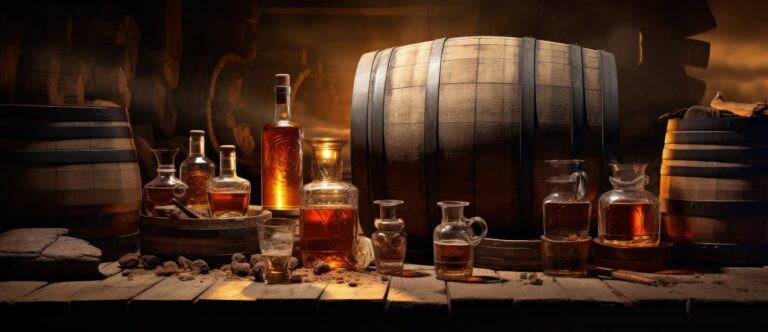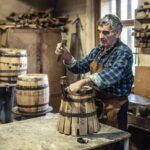Ever wondered how many quarts of whiskey can fit into a standard oak barrel? If you’re like most folks, that thought probably hasn’t crossed your mind. But for a whiskey enthusiast like us, those little details, like barrel capacity, really matter. You want to know just how much of that good stuff is aging and waiting to be bottled.
The answer to this burning question might just surprise you. Oak barrels come in a variety of sizes, but a standard US whiskey barrel typically holds around 53 gallons or about 200 liters. Convert that to quarts, and you’re looking at a whopping 212 quarts in a single barrel. That’s enough delicious bourbon or rye to fill over 280 standard 750mL bottles! Pretty impressive for what seems like a simple oak cask, right? Now you can drop that fun fact and impress your friends the next time you’re enjoying a glass. You’re welcome!
The Fascinating History of Whiskey Barrels
Barrels might seem like humble containers, but their story is surprisingly rich. For centuries, these wooden vessels have been essential for aging and transporting liquids like wine, beer, and, of course, whiskey.
Whiskey barrels, in particular, have a captivating history. They were initially used to age and transport Scotch whisky. However, after Prohibition ended in the US, American bourbon makers faced a shortage of barrels. They started reusing available barrels and quickly discovered that these previously used containers imparted distinct flavors and aromas to their bourbon. This happy accident led to the current practice.
Today, most bourbon is legally required to be aged in new, charred oak barrels. The charring process isn’t just for show; it caramelizes the wood sugars, giving bourbon its characteristic amber color and adding desirable smoky, vanilla, caramel, and spice notes. Over time, the wood naturally softens, allowing the whiskey to extract these complex flavors.
Barrel aging is a huge reason why different bourbons taste so unique. The specific type of wood, the level of char, and even the aging location (like a rickhouse) all play a crucial role in the final flavor profile. After its initial use, a whiskey barrel might get a second life aging other distilled spirits or even other types of whiskey before it’s finally retired.
Ultimately, while a whiskey barrel might appear simple, it plays an integral role in creating a bourbon’s taste, aroma, and character. The next time you take a sip, take a moment to appreciate the humble yet hardworking barrel that made your delicious drink possible.
Standard Whiskey Barrel Sizes and Dimensions
When we talk about standard whiskey barrels, they actually come in a few common sizes, typically ranging from 20 to 200 liters. The most frequently encountered are the 50-liter, 100-liter, and 200-liter barrels.
50-Liter Barrel
A 50-liter barrel is considered smaller but is absolutely perfect for aging whiskey at home or for a small craft distillery. It holds about 13 gallons or approximately 52 quarts of whiskey. These barrels are often crafted from charred American white oak and usually stand around 2 to 3 feet high.
100-Liter Barrel
A popular mid-size choice is the 100-liter or roughly 26-gallon barrel. This size holds about 104 quarts of whiskey and typically stands around 32 to 34 inches high. Many craft distilleries find these barrels ideal for aging their diverse range of whiskey products.
200-Liter Barrel
For larger volumes, a 200-liter or 53-gallon barrel (often referred to as a standard whiskey barrel or bourbon barrel) is the most common choice in the industry. These substantial barrels can hold up to 212 quarts of whiskey and stand around 4 feet high. Large distilleries primarily use barrels of this size, though some smaller operations might use them for specific, higher-volume releases.
As you can see, the volume a standard whiskey barrel can hold varies quite a bit, from 52 to over 200 quarts. The aging potential depends not only on the barrel size and type of whiskey but also on factors like the aging environment and desired maturity, which could range from 3 to 50 years or even more. No matter the size, a charred oak barrel is indispensable for imparting unique flavor and character to the whiskey during the crucial aging process.
Calculating the Total Volume of a Whiskey Barrel
While whiskey barrels come in various sizes, a commonly referenced “standard” whiskey barrel is the 53-gallon bourbon barrel, which holds about 212 quarts. That’s a significant amount of whiskey!
Calculating the Volume
To figure out how many quarts might be in a specific barrel, you first need to calculate its total volume in gallons. Barrels are roughly cylindrical, so you’ll need to measure:
- The diameter of the base: This is the width of the bottom of the barrel.
- The height of the barrel: Measure from the base to the top rim.
Then, you can plug those numbers into the formula for calculating the volume of a cylinder:
Volume=πr2h
Where ‘r’ is the radius of the base (half the diameter) and ‘h’ is the height. Once you have the total volume in cubic inches, you can convert that to gallons and then multiply by 4 to get the volume in quarts.
For example, if your barrel is 24 inches high and has a base diameter of 20 inches:
- Radius of base = 10 inches (diameter ÷ 2)
- Volume = 3.14 × (10 inches)2 × 24 inches = 7536 cubic inches
- Convert to gallons: 7536 cubic inches ÷ 231 cubic inches/gallon ≈ 32.62 gallons
- 32.62 gallons × 4 quarts/gallon ≈ 130.48 quarts
So, a barrel of those dimensions would hold about 130 quarts of whiskey. Keep in mind, a small portion of the volume is taken up by the wood itself, but this calculation gives you a good idea of the theoretical total capacity if it were filled to the brim. Now you know – a full 53-gallon barrel holds approximately 212 quarts of whiskey!
Understanding Proof and Alcohol Percentages
When you see a bottle of whiskey, you’ll notice two important numbers: its proof and its alcohol percentage (also known as alcohol by volume, or ABV). These numbers tell you exactly how much ethanol is in your drink. The proof is simply double the percentage of alcohol by volume. So, an 80 proof whiskey means it’s 40% alcohol.
Higher proof generally means more alcohol, which often translates to more intense and concentrated flavors. Many whiskey drinkers actually prefer higher-proof bourbons, ryes, and Scotches for their bold flavor profiles. However, a higher alcohol content can sometimes feel a bit harsh or “hot” on the palate for some.
Barrel proof whiskey, also often called cask strength whiskey, is bottled directly from the barrel without being diluted with water. This means its proof can range anywhere from 100 to 140 or even higher. This style truly showcases the whiskey in its most natural, unadulterated state.
Most standard whiskey bottlings, however, are carefully cut with water to reduce the proof before bottling. This process helps achieve a consistent flavor profile and a smoother, more mellow drinking experience. Cutting with water is an art form itself, requiring a delicate balance to preserve and enhance the existing flavors.
If a whiskey feels a bit too “hot” or harsh for your liking, don’t hesitate to add a splash of water or an ice cube. This can actually “open up” the flavors and soften the alcohol bite. Just go slowly – you can always add more water, but you can’t take it out!
Ultimately, the ideal alcohol percentage and proof level come down to personal taste and tolerance. Whether you prefer a bold 120 proof or a mellow 80 proof, understanding the relationship between proof, percentage, and flavor will definitely help you find and enjoy your perfect dram.
Doing the Math: Converting Proof Gallons to Liquid Quarts
Getting down to the nitty-gritty of converting proof gallons to liquid quarts is actually quite straightforward. In the world of spirits, a proof gallon contains 231 cubic inches, while a liquid quart holds 57.75 cubic inches.
To convert proof gallons to liquid quarts, you simply:
- Take the number of proof gallons and multiply it by 231. This gives you the total volume in cubic inches.
- Divide that total cubic inches by 57.75. This converts the volume directly to liquid quarts.
For example, let’s say you have a standard 53-gallon whiskey barrel. 53 proof gallons × 231 cubic inches/proof gallon = 12,243 total cubic inches. 12,243 cubic inches ÷ 57.75 cubic inches/liquid quart ≈ 212 liquid quarts.
So, a standard 53-gallon whiskey barrel actually holds around 212 liquid quarts. That’s probably a lot more quarts than you initially imagined could fit into one barrel! The barrel’s clever shape is actually designed to hold liquid incredibly efficiently.
Of course, as the barrel is filled and the whiskey ages, the wood itself soaks up some of the liquid – this is famously known as the “angel’s share.” Also, the “first fill” of a barrel after charring typically imparts the most wood character and color. Subsequent fills, and the blending of different fills, contribute to the wide range of flavors we find in aged whiskeys. The math is just the starting point, but without it, we wouldn’t have the incredible pleasure of whiskey at all!
How Many 750mL Bottles Fit in a Barrel?
A standard whiskey barrel typically holds approximately 53 gallons or about 200 liters of liquid. Since most whiskey is bottled in 750mL sizes (the standard wine bottle size in many regions), that works out to roughly 267 bottles of whiskey from a single barrel.
How Did I Get That Number?
To calculate this, you simply start with the volume of a whiskey barrel in liters (200 liters) and divide that by the volume of a standard whiskey bottle (which is 0.75 liters, as 750mL = 0.75L).
200 L / 0.75 L per bottle ≈ 267 bottles
Naturally, a small amount of liquid is always lost to evaporation during the aging process – that’s our beloved “angel’s share.” So, the actual number of bottles yielded can be slightly less. The precise number will also depend on the specific barrel size and bottle size a distillery uses. But for a good rule of thumb, 267 bottles is a solid estimate.
That’s a remarkable amount of whiskey from one barrel! It’s no wonder many distilleries release special “single barrel” bottlings. With nearly 300 bottles per barrel, there are plenty to share a unique, one-of-a-kind flavor profile from an exceptional barrel.
The next time you’re touring a distillery, keep an eye out for those impressive charred oak barrels patiently aging in the rickhouse. Each one holds hundreds of future bottles of delicious whiskey, slowly developing its character and flavor as it rests. It’s truly an inspiring sight, and the very source of so much enjoyment for whiskey lovers everywhere!
Other Factors That Affect Yield Per Barrel
Beyond just the initial volume, several other factors significantly impact how much whiskey actually ends up in each barrel after aging, including temperature, humidity, and evaporation.
The ambient temperature where barrels are stored plays a crucial role in the chemical reactions that occur as the whiskey ages. Warmer temperatures tend to speed up these reactions, leading to faster maturation but also more significant evaporation. Conversely, colder temperatures slow down the aging process. The ideal range for most whiskey aging is typically between 45 to 65 degrees Fahrenheit.
Humidity, or the amount of moisture in the air, directly affects how much liquid evaporates from the barrels over time. When humidity is higher, less evaporation occurs because the air is already saturated and can’t absorb as much moisture. Lower humidity leads to greater evaporation. Most distilleries aim for a relative humidity of 65-85% for optimal whiskey aging.
The porosity and char level of the barrels themselves also dictate evaporation rates. More porous barrels with a heavier char allow more oxygen to interact with the whiskey and also let more moisture escape. Tightly-grained barrels with a lighter char tend to retain more liquid. Distillers can strategically choose barrels based on their desired rate of maturation and evaporation.
The combined effect of these interacting factors ultimately determines the final yield of aged whiskey from each barrel. By carefully controlling temperature, humidity, barrel selection, and aging time, master distillers expertly craft an exceptional product that’s been slowly transformed into a smooth, flavorful spirit. The end result is a whiskey that’s uniquely characteristic of where it came from.
Getting the Most Out of Your Whiskey Barrels
To truly maximize the utility and longevity of your whiskey barrels, especially if you’re using them for home aging or small-batch production, here are a few key tips to keep in mind.
Seal Properly
Before you even think about putting any whiskey or other spirits into your barrels, make absolutely sure they are properly sealed. If air can sneak in, your precious liquid will not only evaporate faster but also lose its desirable flavors. Take the time to hammer the hoops tight and meticulously check for any tiny cracks or holes in the staves.
Fill at Least Halfway
For the absolute best results during aging, aim to fill your barrels at least halfway, ideally around 15-20 gallons (for a 53-gallon barrel). If you fill it with less, too much of the spirit’s surface area will be exposed to air, leading to excessive evaporation and a reduction in those vital flavor and aroma compounds. Plus, more spirit in the barrel means more contact with the charred wood, which helps impart richer color and taste.
Rotate Occasionally
While your spirit is aging, it’s a good idea to rotate and even flip the barrels every few months. This simple action helps move the spirit into contact with different parts of the charred wood, promoting consistent flavor and color development throughout the liquid. Rotating also helps prevent one side of the barrel from drying out, which could potentially lead to troublesome leaks.
Sample Regularly
The only true way to know if your spirit has reached its full potential is to sample it regularly as it ages. Every 3-6 months, carefully drain a small amount from the barrel and meticulously evaluate its aroma, flavor, and color. Look for those specific notes you want to develop and signs that it might be nearing maturity. Only proceed to bottling once you’re completely satisfied with the results.
By properly caring for your barrels and the spirits within, you’ll be rewarded with a whiskey, brandy, or rum that is uniquely your own. With some patience and the right techniques, you’ll be enjoying the fruits of your labor in no time!
FAQ: Answering Common Questions About Whiskey Barrels and Yield
How many quarts of whiskey can a standard barrel hold?
A typical standard whiskey barrel (like a bourbon barrel) contains around 53 gallons or roughly 200-212 liters, which translates to approximately 212 liquid quarts. That’s a significant amount of whiskey! While barrel sizes can vary slightly, this is a very common average.
How long does it take for whiskey to age?
Whiskey needs time to truly develop its character and complex flavors. The aging time depends heavily on the type of whiskey and can range from as little as 2 years to over 50 years. For instance, bourbon must be aged for a minimum of two years. For most whiskeys, an aging period of 3 to 10 years tends to produce excellent results. Some rare, premium whiskeys are aged for 20 years or more to achieve exceptional depth.
Does the barrel affect the flavor?
Absolutely! The barrel has an enormous impact on a whiskey’s aroma, taste, and color. As whiskey ages in a charred oak barrel, it extracts compounds like vanillin (contributing vanilla notes), lactones (providing coconut and woody notes), and tannins (adding structure and a slightly dry feel). The longer it’s aged, the more flavor it absorbs from the wood. Barrel aging is unequivocally key to producing the distinctive caramel, vanilla, and spice notes found in bourbon and other whiskeys.
Why are whiskey barrels often charred?
Charring oak barrels is a fundamental process because it exposes the wood’s natural sugars and beneficial compounds. These compounds are crucial for giving whiskey much of its distinctive flavor and its rich amber color. The charring process caramelizes these sugars, which then impart delicious notes of vanilla, caramel, and spice to the whiskey during aging. The specific level of char or “toast” helps determine just how much flavor the whiskey will gain from the barrel.
Does whiskey continue to age in an opened bottle?
No, whiskey essentially stops aging once it’s removed from the barrel and bottled. While oxygen exposure in an opened bottle can cause minor changes to the flavor profile over an extended period (sometimes described as “oxidation” or “mellowing”), the true aging process – the interaction with the wood – ends after bottling. For the best quality and taste, most whiskeys are best consumed within 3 to 5 years of opening, although many can last much longer.
Final Thoughts
So there you have it, the not-so-straightforward answer to how many quarts of whiskey can actually fit in an oak barrel. As with many fascinating things in life, the precise number really depends on a lot of interconnected factors. But you can certainly use these estimates as a handy guide the next time you find yourself sipping a smooth glass of bourbon and pondering its incredible journey from the Kentucky backwoods (or the Scottish Highlands) right into your hand.
At the end of the day, does the exact quart capacity truly matter when you have a barrel’s worth of smooth, perfectly aged liquor to enjoy? Probably not. The mysteries of the cooper’s craft might remain, but you can rest assured there’s more than enough delicious whiskey in each barrel to go around. Cheers to that!
